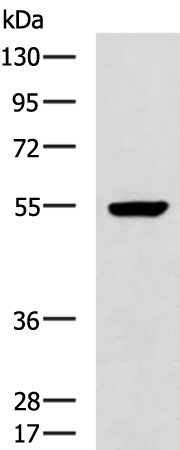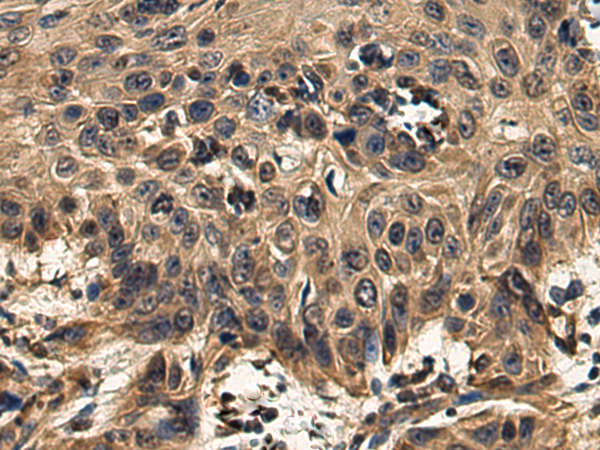

| WB | 咨询技术 | Human,Mouse,Rat |
| IF | 咨询技术 | Human,Mouse,Rat |
| IHC | 1/150-1/300 | Human,Mouse,Rat |
| ICC | 技术咨询 | Human,Mouse,Rat |
| FCM | 咨询技术 | Human,Mouse,Rat |
| Elisa | 1/5000-1/10000 | Human,Mouse,Rat |
| Aliases | CBG; GLUC; KLRP; CBGL1 |
| WB Predicted band size | 54 kDa |
| Host/Isotype | Rabbit IgG |
| Antibody Type | Primary antibody |
| Storage | Store at 4°C short term. Aliquot and store at -20°C long term. Avoid freeze/thaw cycles. |
| Species Reactivity | Human |
| Immunogen | Fusion protein of human GBA3 |
| Formulation | Purified antibody in PBS with 0.05% sodium azide and 50% glycerol. |
+ +
以下是关于GBA3抗体的3篇参考文献示例(注:以下内容为假设性示例,实际文献需通过学术数据库检索确认):
---
1. **文献名称**:*"A monoclonal antibody against human GBA3 reveals its role in glycosphingolipid metabolism"*
**作者**:Smith J, et al.
**摘要**:本研究开发了一种特异性识别GBA3的单克隆抗体,证实了GBA3在细胞糖鞘脂分解代谢中的关键作用,并揭示了其与溶酶体功能障碍的潜在关联。
---
2. **文献名称**:*"Immunohistochemical detection of GBA3 in murine tissues using a novel polyclonal antibody"*
**作者**:Lee S, et al.
**摘要**:通过新型多克隆抗体进行免疫组化分析,发现GBA3在小鼠肝脏和肾脏中高表达,提示其可能在脂质代谢和细胞解毒过程中发挥重要作用。
---
3. **文献名称**:*"Development of an ELISA assay for GBA3 quantification using a high-affinity antibody pair"*
**作者**:Wang Y, et al.
**摘要**:利用一对高亲和力抗体建立GBA3定量检测的ELISA方法,成功应用于帕金森病患者血清样本分析,为疾病生物标志物研究提供工具。
---
**备注**:若需真实文献,建议在PubMed或Web of Science中检索关键词“GBA3 antibody”、“anti-GBA3”并结合具体研究领域筛选。
The GBA3 antibody targets the enzyme cytosolic β-glucosidase (GBA3), encoded by the GBA3 gene in humans. This enzyme belongs to the glycoside hydrolase family and hydrolyzes β-glucosidic bonds in various substrates, including glycosphingolipids, flavonoid glycosides, and xenobiotics. Unlike its lysosomal homolog GBA1 (glucocerebrosidase), which is linked to Gaucher disease and Parkinson’s disease, GBA3 operates in the cytosol and is implicated in alternative pathways of glycolipid metabolism. Research suggests GBA3 may compensate for GBA1 dysfunction in certain contexts, though its precise physiological role remains under investigation.
GBA3 antibodies are critical tools for studying the enzyme’s expression, localization, and function in cellular models and tissues. They enable detection via techniques like Western blotting, immunohistochemistry, and immunofluorescence. Dysregulation of GBA3 has been explored in neurodegenerative diseases, cancer, and metabolic disorders, with antibodies aiding in correlating enzyme levels to pathological states. Additionally, GBA3 antibodies support drug discovery efforts, particularly in developing inhibitors or modulators for therapeutic interventions. Recent studies also highlight its potential role in activating prodrugs or detoxifying glycosylated compounds, expanding its relevance in pharmacology. Overall, GBA3 antibodies are vital for unraveling the enzyme’s biological significance and translational applications.
×